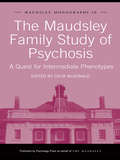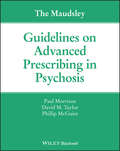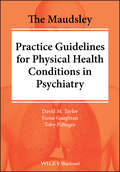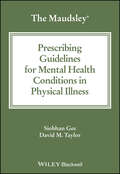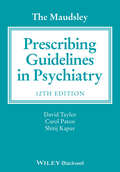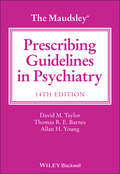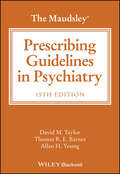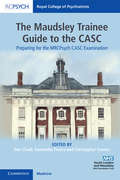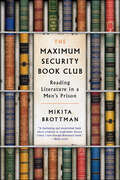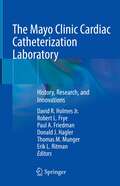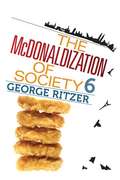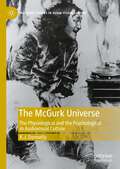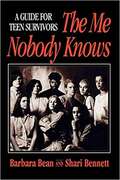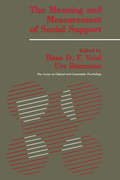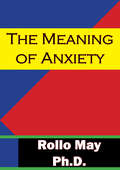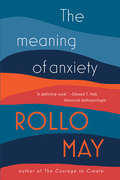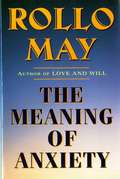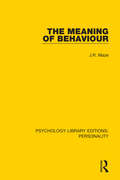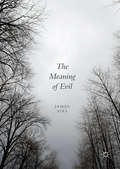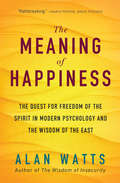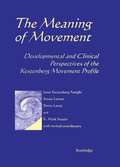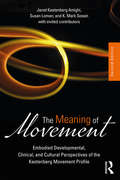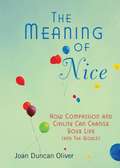- Table View
- List View
The Maudsley Family Study of Psychosis: A Quest for Intermediate Phenotypes (Maudsley Series #53)
by Colm McDonaldPsychotic disorders such as schizophrenia and bipolar disorder are known to be highly heritable. Despite decades of research, however, the genetic variations conferring susceptibility to these illnesses have yet to be identified. Such genetic variations most likely produce abnormalities of brain structure and function from which the clinical features of psychosis emerge. The Maudsley Family Study of Psychosis investigates the genetically produced markers of abnormal brain structure and function (‘intermediate phenotypes’) which underlie the clinical syndrome of schizophrenia, and more recently bipolar disorder. In this book, key findings of this important research program, and their implications for this field, are discussed in detail. Contributors outline research examining brain structure and functioning in patients with schizophrenia and their unaffected first degree relatives, incorporating detailed clinical assessments, magnetic resonance imaging, electrophysiology, eye tracking measures and neuropsychology. This book provides an improved understanding of illness pathways and potential scope for intervention in order to better manage and prevent psychotic disorders and will be of interest to academics and clinicians in the field.
The Maudsley Guidelines on Advanced Prescribing in Psychosis
by Paul Morrison David M. Taylor Phillip McGuireA guide to treating psychosis that provides information on drug options and side-effects in order to allow for weighing treatment options knowledgably The Maudsley Guidelines on Advanced Prescribing in Psychosis offers a resource that puts the focus on the need to treat the individual needs of a patient. The authors – noted experts on the topic – offer an alternative to the one-size-fits-all treatment of psychosis and shows how to build psychiatrist and patient relationships that will lead to effective individual treatment plans. The book provides up-to-date data and information about commonly used anti-psychotic drugs and drugs used in bipolar disorder. The text weighs both the upsides and downsides of each pharmaceutical presented, and helps prescribers and patients weigh the costs and benefits of various options to reach an appropriate treatment plan. The authors highlight the treatment at a population level and the systems in which individual treatments take places. This important resource: Facilitates the tailoring of an appropriate treatment plan for clients manifesting signs of psychosis Offers a comparative strategy that helps gauge the suitability of one treatment plan over another Provides at-hand data and information about commonly used anti-psychotic drugs Includes an understanding of the origins and side-effects of each drug presented The Maudsley Guidelines on Advanced Prescribing in Psychosis offers psychiatrists and other mental health practitioners an essential guide for treating psychosis on an individualized level.
The Maudsley Practice Guidelines for Physical Health Conditions in Psychiatry (The\maudsley Prescribing Guidelines Ser.)
by Fiona Gaughran David M. Taylor Toby PillingerLearn to improve your assessment, investigation, and management of physical health conditions in people with severe mental illness The Maudsley Practice Guidelines for Physical Health Conditions in Psychiatry offers psychiatric and general practitioners an evidence-based and practical guide for the appropriate assessment, investigation, and management of common physical health conditions seen in people with severe mental illness. Written by a renowned team of respected experts in medicine, surgery, pharmacy, dietetics, physiotherapy, and psychiatry, the book bridges the gap between psychiatric and physical health services for the severely mentally ill. The Maudsley Practice Guidelines for Physical Health Conditions in Psychiatry also provides practitioners with expert guidance on making effective referrals to other medical and surgical subspecialties, telling readers what information subspecialties would expect to receive. Its use will improve the quality of clinical care received by mentally ill patients and, by promoting a holistic approach to treatment that considers both body and mind, will enhance the therapeutic relationship between patient and practitioner. The Maudsley Practice Guidelines for Physical Health Conditions in Psychiatry covers the following: Guidance on assessment and management of well over a hundred different medical and surgical presentations commonly seen in people with serious mental illness Management of physical health emergencies in a psychiatric setting Evidence-based approaches to management of physical side effects of psychiatric medications Advice on approaches to promote a healthy lifestyle in people with serious mental illness, such as smoking cessation and changes to diet and physical activity Perfect for both psychiatrists and general practitioners who wish to improve the quality of care they provide to people with serious mental illness, The Maudsley Practice Guidelines for Physical Health Conditions in Psychiatry will be of use to anyone setting out to navigate the divide between the treatment of psychiatric and physical health conditions.
The Maudsley Prescribing Guidelines for Mental Health Conditions in Physical Illness (The Maudsley Prescribing Guidelines Series)
by David M. Taylor Siobhan GeeMeet the challenges of mental health prescribing in the physically unwell with this essential guide Treating mental health conditions in physically unwell patients presents unique challenges for clinicians and other practitioners. The efficacy and safety of psychotropic medications is established in physically healthy patients. In physically unwell people, psychotropics can have different outcomes and give rise to serious adverse effects that can complicate or worsen physical health conditions. Many clinicians face difficult decisions about prescribing for mental health conditions in such cases, and reliable information for them is scarce. The Maudsley® Prescribing Guidelines for Mental Health Conditions in Physical Illness meets this urgent need with a comprehensive guide to the safe and effective pharmacological management of mental illness in physically unwell patients. Covering a wide range of physical health conditions and comorbidities, the book makes evidence-based recommendations on pharmacological interventions. It’s an essential resource for any clinical practitioner looking to balance the physical and mental wellbeing of people with concurrent physical and mental health conditions. The Maudsley® Prescribing Guidelines for Mental Health Conditions in Physical Illness readers will also find: Prescribing recommendations for mental health conditions including depression, anxiety, psychosis and bipolar affective disorderDetailed discussion of the consequences for mental health prescribing in physical health conditions such as cardiac disease, diabetes, chronic obstructive pulmonary disease, and many moreTreatment of complex and frequently encountered clinical scenarios such as restarting psychotropics after overdose and steroid-induced psychiatric conditions The Maudsley® Prescribing Guidelines for Mental Health Conditions in Physical Illness is an essential reference for all prescribers, clinical pharmacists and nurses who work with patients with comorbid mental and physical illnesses.
The Maudsley Prescribing Guidelines in Psychiatry
by Allan H. Young David M. Taylor Thomas R. BarnesThe revised 13th edition of the essential reference for the prescribing of drugs for patients with mental health disorders The revised and updated 13th edition of The Maudsley Prescribing Guidelines in Psychiatry provides up-to-date information, expert guidance on prescribing practice in mental health, including drug choice, treatment of adverse effects and how to augment or switch medications. The text covers a wide range of topics including pharmacological interventions for schizophrenia, bipolar disorder, depression and anxiety, and many other less common conditions. There is advice on prescribing in children and adolescents, in substance misuse and in special patient groups. This world-renowned guide has been written in concise terms by an expert team of psychiatrists and specialist pharmacists. The Guidelines help with complex prescribing problems and include information on prescribing psychotropic medications outside their licensed indications as well as potential interactions with other medications and substances such as alcohol, tobacco and caffeine. In addition, each of the book’s 165 sections features a full reference list so that evidence on which guidance is based can be readily accessed. This important text: Is the world’s leading clinical resource for evidence-based prescribing in day-to-day clinical practice and for formulating prescribing policy Includes referenced information on topics such as transferring from one medication to another, prescribing psychotropic medications during pregnancy or breastfeeding, and treating patients with comorbid physical conditions, including impaired renal or hepatic function. Presents guidance on complex clinical problems that may not be encountered routinely Written for psychiatrists, neuropharmacologists, pharmacists and clinical psychologists as well as nurses and medical trainees, The Maudsley Prescribing Guidelines in Psychiatry are the established reference source for ensuring the safe and effective use of medications for patients presenting with mental health problems.
The Maudsley Prescribing Guidelines in Psychiatry
by David Taylor Carol Paton Shitij KapurHelps with complex prescribing needs The evidence base for drug treatments in psychiatry ranges from meta-analyses and randomised controlled clinical trials to single case reports, and from NICE guidelines to individual SPCs. Where do you look for information when transferring a patient from one drug to another? Where do you find a clear overview when dealing with a complex patient (e. g, with co-morbid epilepsy or liver disease or HIV infection)? Where can you seek advice on prescribing psychotropics during pregnancy? The Maudsley Prescribing Guidelines in Psychiatry! The leading clinical reference for handling prescribing problems as encountered in daily practice and for formulating prescribing policy. Evidence-based and written by experts This book is the essential guide for anyone responsible for prescribing, dispensing or administering drugs for patients with mental health disorders. All the evidence has been reviewed and summarized succinctly by an expert team of psychiatrists and pharmacists. New content and improved format This new edition makes greater use of tables and boxes to facilitate quick reference and includes new sections on cytochrome-mediated interactions and psychiatric side effects of non-psychotropic drugs. Clinically relevant Chapters address plasma monitoring, schizophrenia, bipolar disorder, depression and anxiety, children and adolescents, substance abuse and special patient groups. Each section has a full reference list. The book covers prescribing drugs outside their licensed indications and their interaction with substances such as alcohol, nicotine and caffeine. Useful for all levels of experience Trainees will gain important information regarding the rational, safe and effective use of medications for patients with mental illness. Experienced clinicians will find excellent guidance regarding more complex issues that they may not encounter regularly. Why the Maudsley Prescribing Guidelines in Psychiatry? Long recognized as an international trailblazer in mental health care, the Maudsley Hospital earned its reputation for excellence in both in-patient and community care. It is highly regarded for its research, and pioneered the use of clinical neuroscience. You can trust The Maudsley Prescribing Guidelines in Psychiatry to be scientifically sound and clinically effective.
The Maudsley Prescribing Guidelines in Psychiatry (The Maudsley Prescribing Guidelines Series)
by Allan H. Young David M. Taylor Thomas R. BarnesThe Maudsley® Prescribing Guidelines in Psychiatry The new edition of the world-renowned reference guide on the use of medications for patients presenting with mental health problems The Maudsley Prescribing Guidelines in Psychiatry is the essential evidence-based handbook on the safe and effective prescribing of psychotropic agents. Covering both common and complex prescribing situations encountered in day-to-day clinical practice, this comprehensive resource provides expert guidance on drug choice, minimum and maximum doses, adverse effects, switching medications, prescribing for special patient groups, and more. Each clear and concise chapter includes an up-to-date reference list providing easy access to the evidence on which the guidance is based. The fourteenth edition has been fully updated to incorporate the latest available research, the most recent psychotropic drug introductions, and all psychotropic drugs currently used in the UK, USA, Canada, Australia, New Zealand, and Japan. Several new sections cover topics such as deprescribing of major psychiatric drugs, prescribing psychotropics at the end of life, the treatment of agitated delirium, the genetics of clozapine prescribing, the use of weekly penfluridol, and the treatment of psychotropic withdrawal. Featuring contributions by an experienced team of psychiatrists and specialist pharmacists, the new edition of The Maudsley Prescribing Guidelines in Psychiatry: Provides succinct coverage of drug treatment of psychiatric conditions and formulating prescribing policy in mental health Covers a wide range of psychiatric conditions including schizophrenia, bipolar disorder, depression and anxiety, borderline personality, eating disorders, and many others Provides advice on prescribing for children and adolescents, older people, pregnant women, and other special patient groups Offers new sections on genetic prescribing, long-acting injectable formulations, ketamine administration and uses, and dopamine super-sensitivity Includes referenced information on off-label prescribing, potential interactions with other substances such as alcohol, tobacco, and caffeine, and treating patients with comorbid physical conditions Whether in the doctor’s office, in the clinic, or on the ward, The Maudsley Prescribing Guidelines in Psychiatry, Fourteenth Edition is a must-have for psychiatrists, pharmacists, neuropharmacologists, clinical psychologists, nurses, and other healthcare professionals working in mental health, as well as trainees and students in medicine, pharmacy, and nursing.
The Maudsley Prescribing Guidelines in Psychiatry (The Maudsley Prescribing Guidelines Series)
by Allan H. Young David M. Taylor Thomas R. BarnesThe most up-to-date edition of the gold-standard handbook on the safe and effective prescribing of psychotropic agents Prescribing medications that treat mental illness is a challenging but essential component of clinical practice. Successful treatment outcomes require careful drug choice and dosage, and other considerations can also have an important impact on patient experiences and long-term care. In the newly revised fifteenth edition of The Maudsley Prescribing Guidelines in Psychiatry, you will find up-to-date and authoritative guidance on prescribing psychotropic medications to patients. It is an indispensable evidence-based handbook that will continue to serve a new generation of clinicians and trainees. The book includes analyses of all psychotropic drugs currently used in the United States, the United Kingdom, Canada, Australia, New Zealand, and Japan. It also contains detailed discussions of common and uncommon adverse effects, the ramifications of switching medications, special patient groups, and other clinically relevant subjects. A fully updated reference list closes out each section, as well. The Maudsley Prescribing Guidelines in Psychiatry is perfect for trainees seeking essential and accurate information on the rational, safe, and effective use of medications for patients with mental illness. Practising clinicians will also benefit from the included guidance on complex issues that might arise less frequently.
The Maudsley Trainee Guide to the CASC: Preparing for the MRCPsych CASC Examination
by Dan Cleall Samantha Perera Christopher TraversWritten by graduates of the internationally renowned Maudsley Training Programme, who have all recently sat the CASC examination, this book provides clear, practical guidance to passing the Royal College of Psychiatrists' CASC. Divided according to psychiatric subspecialties, each chapter includes practice clinical scenarios. These clinical scenarios are broken down into candidate instructions, actor instructions and constructive candidate feedback. This enables candidates to practice not only with their clinical peers, but with friends and family as well. An additional chapter is dedicated to practical information about the exam and tips for the day to further equip readers in what to expect, and reduce anxieties about the exam itself. Another chapter is specifically devoted to addressing the needs of international and BAME medical graduates. Relevant and reliable throughout, this is a must-have resource for psychiatric trainees looking to improve their clinical skills and gain their MRCPsych qualification.
The Maximum Security Book Club: Reading Literature in a Men's Prison
by Mikita BrottmanA riveting account of the two years literary scholar Mikita Brottman spent reading literature with criminals in a maximum-security men’s prison outside Baltimore, and what she learned from them—Orange Is the New Black meets Reading Lolita in Tehran.On sabbatical from teaching literature to undergraduates, and wanting to educate a different kind of student, Mikita Brottman starts a book club with a group of convicts from the Jessup Correctional Institution in Maryland. She assigns them ten dark, challenging classics—including Conrad’s Heart of Darkness, Shakespeare’s Macbeth, Stevenson’s Dr. Jekyll and Mr. Hyde, Poe’s story “The Black Cat,” and Nabokov’s Lolita—books that don’t flinch from evoking the isolation of the human struggle, the pain of conflict, and the cost of transgression. Although Brottman is already familiar with these works, the convicts open them up in completely new ways. Their discussions may “only” be about literature, but for the prisoners, everything is at stake.Gradually, the inmates open up about their lives and families, their disastrous choices, their guilt and loss. Brottman also discovers that life in prison, while monotonous, is never without incident. The book club members struggle with their assigned reading through solitary confinement; on lockdown; in between factory shifts; in the hospital; and in the middle of the chaos of blasting televisions, incessant chatter, and the constant banging of metal doors.Though The Maximum Security Book Club never loses sight of the moral issues raised in the selected reading, it refuses to back away from the unexpected insights offered by the company of these complex, difficult men. It is a compelling, thoughtful analysis of literature—and prison life—like nothing you’ve ever read before.
The Mayo Clinic Cardiac Catheterization Laboratory: History, Research, and Innovations
by David R. Holmes Paul A. Friedman Donald J. Hagler Robert L. Frye Thomas M. Munger Erik L. RitmanThis book explores the history of the Mayo Clinic Cardiac Catheterization Laboratory from 1940 to present day. It examines the life and journey of the Cardiac Catheterization Lab and its ultimate success in implementing the vision of the Mayo philosophy of emphasizing collaboration between lab-based scientists and clinical health care professionals to bring innovation to the clinical practice and lead landmark changes in the practice of medicine profoundly enhancing what we can offer to patients and society alike. The book is divided into decades, with separate sections in each decade on key cardiology topics such as congenital heart disease, coronary heart disease, hemodynamics, pacing, and electrophysiology (EP). Chapters will highlight training, advances, new procedures, new technologies, and fundamental changes to the field throughout the decades, attributed to the work done by Cath lab personnel. Chapters also identify the problems faced, the unmet clinical needs of patients and society, problems solved, and things learned and transmitted into the clinical arena along the way. The Mayo Clinic Cardiac Catheterization Laboratory will be a valuable resource for health care professionals, clinicians, scientists, innovators, administrators, and small and large device manufacturing companies as well as historians and past and present patients.
The McDonaldization of Society 6, Sixth Edition
by George RitzerThe book demonstrates the power of the sociological imagination to today's readers in a way that few other books have, linking theory to contemporary pop-culture examples that resonate with 21st-century students. This Sixth Edition includes a new concluding Chapter 10 The DeMcDonaldization Society? that examines recent phenomena like Web 2.0 and its relationship to the McDonaldization thesis.
The McGurk Universe: The Physiological and the Psychological in Audiovisual Culture (Palgrave Studies in Audio-Visual Culture)
by K.J. DonnellyThis book reconsiders audiovisual culture through a focus on human perception, with recourse to ideas derived from recent neuroscience. It proceeds from the assumption that rather than simply working on a straightforward cognitive level audiovisual culture also functions more fundamentally on a physiological level, directly exploiting precise aspects of human perception. Vision and hearing are unified in a merged signal in the brain through being processed in the same areas. This is illustrated by the startling ‘McGurk Effect’, whereby the perception of spoken sound is changed by its accompanying image, and counterpart effects which demonstrate that what we see is affected by different sounds accompanying sounds. This blending of sound and images into a whole has become a universal aspect of culture, not only evident in films and television but also in video games and short Internet clips. Indeed, this aesthetic formation has become the dominant of this period. The McGurk Universe attends to how audiovisual culture engages with and mediates between physiological and psychological levels.
The Me Nobody Knows: A Guide for Teen Survivors
by Barbara Bean Shari BennettThe first book for sexually abused teens to turn to. <p><p> When teenagers are victims of sexual abuse, the 'normal' problems of adolescence are exacerbated. The authors validate the conflicting emotions aroused by sexual abuse and offer these adolescents simple, concrete advice about reporting the abuse and how to seek counseling. <p><p> This unique book is for teenagers in therapy that have been victims of sexual abuse, as well as for their therapists. Through written, visual, and relaxation exercises, the book shows survivors how to begin to cope.
The Meaning And Measurement Of Support
by Hans O. F. Veiel Urs BaumannContains papers from an international symposium held at the Werner Reimers Foundation in Bad Homburg, Germany in May 1990. They address the concern that social support research has fragmented into separate areas and that there is a lack of definition concerning social support.
The Meaning Of Anxiety
by Rollo MayWhen this important work was originally published in 1950--the first book in this country on anxiety--it was hailed as a work ahead of its time.This book is the result of several years of exploration, research, and thought on one of the most urgent problems of our day. Clinical experience has proved to psychologists and psychiatrists generally that the central problem in psychotherapy is the nature of anxiety. To the extent that we have been able to solve that problem, we have made a beginning in understanding the causes of integration and disintegration of personality.But if anxiety were merely a phenomenon of maladjustment, it might well be consigned to the consulting room and the clinic and this book to the professional library. The evidence is overwhelming, however, that men and women of today live in an "age of anxiety." If one penetrates below the surface of political, economic, business, professional, or domestic crises to discover their psychological causes, or if one seeks to understand modern art or poetry or philosophy or religion, one runs athwart the problem of anxiety at almost every turn. There is reason to believe that the ordinary stresses and strains of life in the changing world of today are such that few if any escape the need to confront anxiety and to deal with it in some manner.This study seeks to bring together in one volume the theories of anxiety offered by modern explorers in different areas of our culture, to discover the common elements in these theories, and to formulate these concepts so that we shall have some common ground for further inquiry. If the synthesis of anxiety theory presented here serves the purpose of producing some coherence and order in this field, a good part of the writer's goal will have been achieved.
The Meaning Of Hitler
by Ewald Osers Sebastian HaffnerThis is a remarkable historical and psychological examination of the enigma of Adolf Hitler who he was, how he wielded power, and why he was destined to fail. Beginning with Hitler's early life, Sebastian Haffner probes the historical, political, and emotional forces that molded his character. In examining the inhumanity of a man for whom politics became a substitute for life, he discusses Hitler's bizarre relationships with women, his arrested psychological development, his ideological misconceptions, his growing obsession with racial extermination, and the murderous rages of his distorted mind. Finally, Haffner confronts the most disturbing question of all: Could another Hitler rise to power in modern Germany?
The Meaning of Anxiety
by Rollo MayIn this revised edition of his classic work--the first modern book on anxiety following Freud and Kierkegaard--psychologist Rollo May brings order and lucidity to the subject of anxiety. Rollo May challenges the idea that "mental health is living without anxiety," believing it is essential to being human. He explores how it can relieve boredom, sharpen sensibilities, and produce the tension necessary to preserve human existence. May sees a link extending from anxiety to intelligence, creativity, and originality, and guides the reader away from destructive ways to positive ways of dealing with anxiety. He convincingly proposes that anxiety can impel personal change, as it is only by confronting and coping with it that self-realization can occur.
The Meaning of Anxiety (Revised Edition)
by Rollo MayIn this revised edition, Rollo May deepens his exploration into anxiety theory. Dr. May challenges the idea that mental health means living without anxiety, and he explores anxiety's potential for self-realization as well as ways to avoid its destructive aspects.
The Meaning of Behaviour (Psychology Library Editions: Personality #11)
by J.R. MazeOriginally published in 1983, this title is a determined attack on personality theories current at the time. It critically examines their basic motivational constructs and rejects any that invoke goal-seeking as being inescapably teleological and therefore unacceptable as natural science. Dr Maze argues the necessity for an unqualified determinism in psychology, yet one that incorporates the role of cognitive processes in the formation of behaviour. However, action theories which profess to offer a causal account of apparently goal-seeking or voluntarist behaviour by reference to the internal states of desire for a goal and a belief about how to get it are also dismissed. For the concept of belief as an internal state is argued to be a relativistic one, defined as being intrinsically related to its object. This is an incoherent notion and one which cannot specify anything acceptable as a causal state. The one motivational theory in dynamic psychology which offered a solution to these problems was Sigmund Freud’s formulation of his instinctual drive concept, defined as an innate physiological driving mechanism with preformed consummatory behaviours: his ‘specific actions’. But his hydraulic models have been patronisingly dismissed by modern neurologists, arguing that there are no ‘flush-toilets’ in the central nervous system. This book argues that such a glib dismissal is shallow minded, and that a reformulation of Freud’s concept in terms of modern neuroscience is readily available, though the problem of identifying the relevant structures remains formidable. The book is of immediate interest to all those seriously concerned with the springs and meanings of human behaviour, whether they be psychologists, psychoanalysts, philosophers or those generally interested in social and ethical theory.
The Meaning of Evil
by James SiasIn this book, James Sias investigates the psychologies of those who have acted in ways widely regarded as evil, and uses this psychological data as a basis for developing his own theory of evil. Sometimes, he claims, an action is so horrific and despicable that a term like "wrong" seems to fall short of capturing its moral status. Likewise, occasionally a person's character is corrupt in such a way that ordinary trait terms like "selfish" or "insensitive," or more general labels like "bad" or "immoral," seem inadequate. In such cases, we often resort to calling the person or action "evil. " But what does this term mean? What is it that makes a person or action morally evil? Taking a cue from Hannah Arendt, Sias argues that this sort of evil is essentially a matter of regarding others as "morally superfluous. " In other words, evil is a matter of utter moral disregard. In the course of developing and defending this view, Sias also describes and critiques a number of prominent theories of evil proposed by philosophers in recent years.
The Meaning of Happiness: The Quest for Freedom of the Spirit in Modern Psychology and the Wisdom of the East
by Alan WattsDeep down, most people think that happiness comes from having or doing something. Here, in Alan Watts&’s groundbreaking third book (originally published in 1940), he offers a more challenging thesis: authentic happiness comes from embracing life as a whole in all its contradictions and paradoxes, an attitude that Watts calls the &“way of acceptance.&” Drawing on Eastern philosophy, Western mysticism, and analytic psychology, Watts demonstrates that happiness comes from accepting both the outer world around us and the inner world inside us — the unconscious mind, with its irrational desires, lurking beyond the awareness of the ego. Although written early in his career, The Meaning of Happiness displays the hallmarks of his mature style: the crystal-clear writing, the homespun analogies, the dry wit, and the breadth of knowledge that made Alan Watts one of the most influential philosophers of his generation.
The Meaning of Movement: Developmental and Clinical Perspectives of the Kestenberg Movement Profile
by Janet Kestenberg Amighi Susan Loman Penny Lewis K. Mark SossinThe primary objective of this book is to present the Kestenberg Movement Profile (KMP)--a multi-tiered system for the notation of observed movement patterns, classification of these patterns, and analysis of an individual's movement repertoire.
The Meaning of Movement: Embodied Developmental, Clinical, and Cultural Perspectives of the Kestenberg Movement Profile
by Janet Kestenberg Amighi K. Mark Sossin Susan LomanThe new edition of The Meaning of Movement serves as a guide to instruction in the Kestenberg Movement Profile (KMP) and as the system’s foremost reference book, sourcebook, and authoritative compendium. This thoroughly updated volume interweaves current developmental science, cultural perspectives, and KMP-derived theory and methods for research and techniques for clinical practice. Through the well-established KMP, clinicians and researchers in the realms of nonverbal behavior and body movement can inform and enrich their psychological interpretations of movement. Interdisciplinary specialists gain a way to study the embodiment of cognition, affects, learning styles, and interpersonal relations based on observation and analysis of basic qualities of movement.
The Meaning of Nice
by Joan Duncan OliverDiscover the hidden power of nice. The Meaning of Nice is a multi-faceted exploration of a simple word and how it has developed over time and among various disciplines. With emphasis on philosophy, positive psychology and interpersonal relationships, Joan Duncan Oliver probes theories and practices to explain why and how nice girls can get the corner office and nice guys can finish first. We tend to associate "nice" people with kindness and good manners - it's an indistinct, generic kind of praise. Joan Duncan Oliver restores the power of nice, and shows how this complex quality can change your life, and has never been more crucial to our well-being as individuals and as a society.
